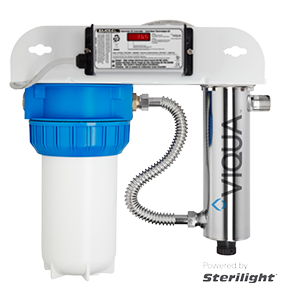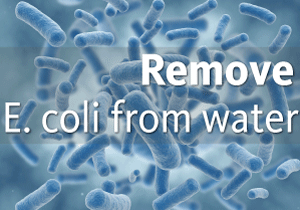
How can I remove e.coli bacteria from my water?


Viqua VH200-F10 | List Price: CDN$ Our Price: CDN$871.00 You save: $359.00 Found a Lower Price? Request a Price Beat |

 Lowest Price Guaranteed!If you find a lower price on this product call us or Click here to request a price beat. |
This is one of the most common questions for those concerned about healthy drinking water. There are several options to treat e.coli in water - some methods are more efficient than others and some simply don't work. HomePlus recommends UV disinfection and here's why...
What water treatment technologies are best to treat e.coli?
UV disinfection is the preferred method - no chemicals, cost effective, easy to maintain, does not change taste or smell, and is extremely effective. The UV dose needed to kill 99.99% of e.coli is approximately 6 mJ/cm2. Most residential UV units provide a UV dose of 30-40 mJ/cm2 - more than enough to kill e.coli and any other harmful pathogens.
Chlorine and Chloramine - this method can be very effective, but is difficult for individual owners to operate properly without under or over-dosing. Chlorine also changes the taste and smell of the water and there is a risk of formation of disinfection byproducts such as trihalomethanes and HAA. Due to a number of associated health risks, it is vitally important to regulate what chemicals we handle and put into our bodies, and this makes using chlorine treatment a less appealing option.
Membrane technologies such as reverse osmosis, nano-filtration, and ultrafiltration can work but it can be very difficult to monitor ongoing performance and effectiveness and there is a well-documented risk of bacteria growing through the membranes. Hence, we do not recommend this approach.
Cartridge filters, carbon filters, pitcher style filters (Eg. Brita) do not remove e.coli. e.coli are too small and simply pass through these filters. Filters containing activated carbon are actually a great place for bacteria to grow and multiply.
What is e.coli?
There are a number of different types of e.coli and some are more harmful than others. e.coli typically live in the intestines of animals as well as people. In fact, most e.coli are harmless and it may surprise you to hear that these e-coli are an important part of a healthy intestinal tract. The e.coli you hear about in the news are pathogenic and can cause illness or even death in extreme cases. Pathogenic e.coli can be transmitted through fecal material from animals or humans as well as through contaminated water or food.
How big are e.coli?

e.coli are extremely small which makes it next to impossible to filter them out. A typical e.coli microbe is only approximately 2 micrometers long and about half a micrometer in diameter. For comparison, a human hair strand is about 50 micrometers thick.
How does e.coli get into our water?
Most pathogenic e.coli enter the water system through human or animal waste contamination. This can be caused as a result of the poor treatment of septic and sewage, leaching of animal manure, or storm water runoff. A poorly constructed well or poor well maintenance can also lead to the contamination of groundwater. Flooding increases the risk of contamination in wells, particularly in shallow wells or wells that have been submerged for lengthy periods of time.
What types of water sources are at greatest risk?
Given that e.coli is abundant in cattle, goats, sheep, and other livestock, farming activities greatly increase the probability of e.coli contamination. Following heavy precipitation, the e.coli from animal waste can be washed into creeks, irrigation ponds, lakes, and groundwater. Poorly designed and maintained septic fields can also cause human produced e.coli to leach into surrounding water supplies. When these water sources are used for drinking water and are not treated or are inadequately treated, e.coli contamination can become a significant threat.
How do you know if you have e.coli in your water?
Because coliform bacteria have no taste, smell, or color, the only way you will know for certain if you have e.coli in your water is get your water tested at least annually at a certified water testing lab. For water supplies that are contaminated with bacteria, the water should be tested at least every three months. A comprehensive water test will identify a full suite of bacterial and chemical parameters. It is a good idea to have your water source tested after heavy rainfall as this is when there is the greatest risk of contamination.
If e.coli is identified in your water test it means that fecal contamination is entering the water system and potentially dangerous pathogens may be present. The bacteria source must be identified and corrected. Some questions are you can ask are: Is there enough distance from the well and potential contamination sources? Is there a malfunctioning septic system in the area? Does the well require repair or rehabilitation?
If there is no e.coli present but coliforms are identified, it could be indicative of a bacteria layer called a biofilm within your well or plumbing system. It may also indicate that surface water is getting into your well or that your well water comes from an aquifer that contains bacteria, as can be evident in wells coming from a shallow source.
What harm can e.coli cause?
e.coli can cause a number of illnesses and diseases which can vary in symptoms and severity. The most common symptoms of waterborne illness include headache, mild fever, diarrhea, nausea and vomiting. Symptoms usually appear within 1-10 days and usually end within 5-10 days. As with any significant health risk, infants, the elderly and those with compromised immune systems are more susceptible and may experience more severe effects. In more acute cases, e.coli can infect the lungs, nervous system, kidneys, liver and can even be fatal. While most people will completely recover on their own, more severe cases require hospital care and may lead to long-lasting health effects or death.
How many people are affected annually?
While the majority of e.coli cases are never reported, it is estimated that there are approximately 2,000 cases of e.coli annually in Canada and 73,000 cases in the U.S., leading to about 61 annual deaths.
Examples of e.coli outbreaks:
The Walkerton, Ontario, Canada e.coli outbreak in 2000 is probably one of the most prominently known. The water supply contamination lead to 6 deaths in the small community and sickened more than 2,000 people. The outbreak lead to charges against two operators who were deemed to be relatively uninformed about water safety and it was determined that the outbreak was caused by heavy rainfall and cattle manure which was used to fertilize crops less than 100 metres from one of the community intake wells.
There have also been a number of outbreaks in the U.S. such as the Alpine, Wyoming episode in 1998 which sickened 157 people. This outbreak was also caused by drinking municipal water which was found to have microbiologic evidence of fecal organisms. It was found that this outbreak affected visitors at a significantly higher rate than residents likely due to the longer-term nature of the problem.
For 2011-2012, the most recent years for which finalized data were available, public health officials from 32 states and Puerto Rico reported 90 recreational water-associated outbreaks to CDC's Waterborne Disease and Outbreak Surveillance System (WBDOSS) via the National Outbreak Reporting System (NORS). The 90 outbreaks resulted in at least 1,788 cases, 95 hospitalizations, and one death.
What else can be done to reduce the risk of e.coli contamination?
There are a number of precautions that can be taken which will dramatically reduce the risk of e.coli contamination in water suppies. Some of the most common precautions include periodically shock treating the well and your plumbing system with bleach/chlorine, ensuring that the well is properly capped and sealed, and keeping potential bacteria sources like septic fields and animals as far away from your water source as possible. Those involved in farming activity can take further precautions such as not wearing farm work clothes or footwear in the home, and using proper hygiene particularly after contact with animals.
Other precautions include keeping water toughs and drinking bowls clean, keeping pumps, pipes and well equipment off the ground when being repaired and disinfecting any water placed in a well. Never use water from a lake or pond in your well.
Summary:
With a proper water treatment technology, regular testing and maintenance of your water source, and precaution around farming activities and septic systems, you can enjoy healthy drinking water without the worry of e.coli contamination.


 (2)
(2)

